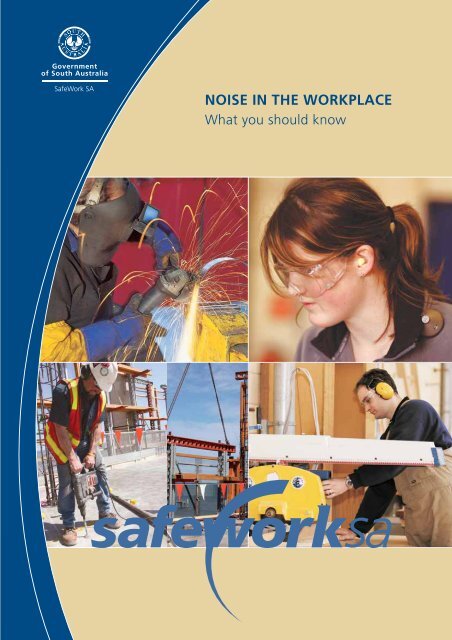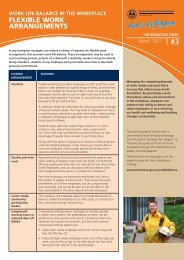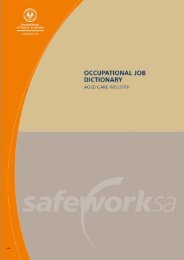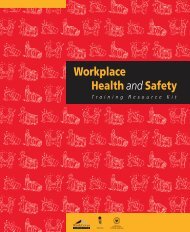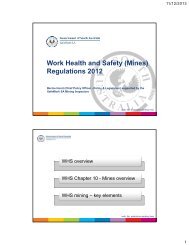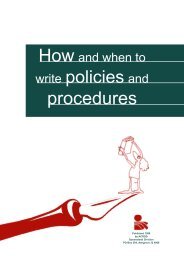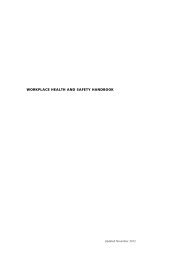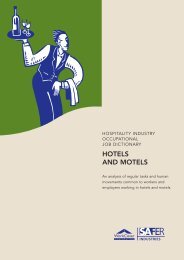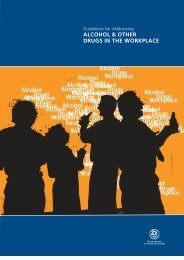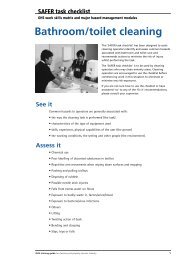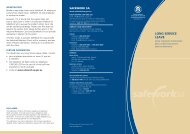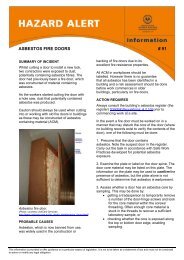NOISE IN THE WORKPLACE - SafeWork SA
NOISE IN THE WORKPLACE - SafeWork SA
NOISE IN THE WORKPLACE - SafeWork SA
Create successful ePaper yourself
Turn your PDF publications into a flip-book with our unique Google optimized e-Paper software.
<strong>NOISE</strong> <strong>IN</strong> <strong>THE</strong> <strong>WORKPLACE</strong><br />
What you should know
Disclaimer<br />
This publication contains information regarding occupational health and safety. It includes some of your obligations under the<br />
Occupational Health and Safety legislation that <strong>SafeWork</strong> <strong>SA</strong> administers. To ensure you comply with your legal obligations you must<br />
refer to the appropriate acts and regulations.<br />
This publication may refer to legislation that has been amended or repealed. When reading this publication you should always refer<br />
to the latest laws.
CONTENTS<br />
<strong>NOISE</strong> AND RISKS TO HEALTH 2<br />
<strong>NOISE</strong> FACTS 5<br />
RELEVANT <strong>NOISE</strong> LEGISLATION 8<br />
<strong>WORKPLACE</strong> MATTERS: WHAT EMPLOYERS, WORKERS AND SELF-EMPLOYED PERSONS SHOULD KNOW 9<br />
<strong>NOISE</strong> AND HEAR<strong>IN</strong>G PROTECTORS 11<br />
WHERE CAN I GET FUR<strong>THE</strong>R <strong>IN</strong>FORMATION? 14<br />
<strong>NOISE</strong> HAZARD IDENTIFICATION CHECKLIST 15<br />
DECIBEL LEVELS OF COMMON SOUNDS 16<br />
<strong>NOISE</strong> <strong>IN</strong> <strong>THE</strong> <strong>WORKPLACE</strong> What you should know 1
2<br />
<strong>NOISE</strong> AND RISKS TO HEALTH<br />
WHAT IS <strong>NOISE</strong>?<br />
Noise is an unwanted or damaging sound that may damage<br />
your hearing and cause other health effects such as stress,<br />
hypersensitivity to noise, increased blood pressure and<br />
increased heart rate. It can also interfere with communication<br />
at work, which could lead to accidents.<br />
The normal range of hearing for a healthy young person is<br />
from approximately 20 Hz (Hertz) to 20,000 Hz (20 kHz).<br />
Our ears are more sensitive to the middle frequencies, which<br />
range from 500 Hz to 4000 Hz - the speech frequencies.<br />
Hertz is a measure of the pitch or frequency of sound,<br />
sometimes referred to as cycles per second.<br />
HOW DO WE HEAR?<br />
Noise causes sound waves that make our ear drums vibrate.<br />
These vibrations are received by hair cells in the inner ear,<br />
which flatten according to the frequency and loudness of the<br />
sound and stimulate nerves that pass messages to the brain.<br />
The outer ear<br />
collects and<br />
funnels sound<br />
waves along the<br />
ear canal to the<br />
eardrum.<br />
The middle ear<br />
contains three tiny<br />
bones, called<br />
ossicles. When<br />
sound waves strike<br />
the eardrum, the<br />
ossicles conduct the<br />
vibration to the<br />
cochlea in the<br />
inner ear.<br />
<strong>NOISE</strong> <strong>IN</strong> <strong>THE</strong> <strong>WORKPLACE</strong> What you should know<br />
Hair cells within the<br />
inner ear respond<br />
to vibrations by<br />
generating nerve<br />
impulses. The brain<br />
interprets this as<br />
sound. (It is the hair<br />
cells that are<br />
damaged by excessive<br />
noise, which leads<br />
to deafness.)<br />
HOW DOES <strong>NOISE</strong> DAMAGE MY HEAR<strong>IN</strong>G?<br />
Very loud sounds make the hair cells collapse and flatten<br />
temporarily, resulting in temporary deafness. This is referred<br />
to as a temporary threshold shift and may last hours or<br />
longer depending on the degree of noise exposure.<br />
This temporary hearing loss may also be accompanied by<br />
a ringing sensation called tinnitus.<br />
If this severe noise exposure is repeated over many years,<br />
the hair cells in the inner ear become permanently damaged<br />
resulting in permanent hearing loss. This is referred to as<br />
permanent threshold shift.<br />
Immediate permanent hearing loss can also occur if someone<br />
is exposed to very intense or explosive sounds (e.g. gunshot<br />
or an explosion). This type of damage is known as acoustic<br />
trauma. In some cases a very intense sound can actually<br />
perforate the eardrum.<br />
The harmful effects of noise are cumulative and not necessarily<br />
confined to the workplace. For instance, the use of personal<br />
stereo units and frequenting discos and clubs may result in<br />
young people having some early damage to their hearing<br />
before they even join the workforce.
HOW CAN <strong>NOISE</strong> AFFECT YOUR LIFE?<br />
Noise-induced hearing loss is one of the most common<br />
occupational injuries, resulting in health problems for many<br />
workers and it presents a significant social and economic cost<br />
to Australia.<br />
The human cost is also high. This includes lost jobs, increased<br />
absenteeism, reduced performance, lost opportunities for<br />
promotion or other employment and impaired family and social<br />
relationships. In addition, if your hearing is damaged it could<br />
cause a workplace accident.<br />
The first sign of noise-induced hearing loss is often the difficulty<br />
to hear high-pitched sounds, such as consonants (e.g. ‘t’, ‘d’, ‘s’)<br />
and the voices of women and children. When more than one<br />
person is speaking or there is a background noise, the problem<br />
becomes worse.<br />
Noise-induced hearing loss occurs gradually over a long period<br />
of time and unfortunately, hearing loss is permanent<br />
(see Figure 1).<br />
Hearing aids can offer limited help in decoding the distorted<br />
messages, but they can never fully compensate for hearing loss.<br />
ARE <strong>THE</strong>RE ANY METHODS OF TREATMENT FOR<br />
<strong>NOISE</strong>-<strong>IN</strong>DUCED HEAR<strong>IN</strong>G LOSS AND RELATED<br />
CONDITIONS?<br />
Permanent hearing damage that is either caused immediately<br />
through a sudden extremely loud noise or gradually due to<br />
prolonged exposure to unacceptable noise levels is incurable.<br />
Tinnitus, which is a ringing, whistling, buzzing or humming in<br />
the ear, is another possible problem arising from excessive<br />
exposure to noise. This distressing condition can also lead to<br />
disturbed sleep and can reduce a person’s enjoyment of life.<br />
While there is no cure, some people who suffer from tinnitus<br />
may be assisted by undertaking tinnitus retraining therapy,<br />
which offers a way to manage the condition.<br />
For further information about tinnitus retraining therapy visit<br />
www.neuromonics.com.au<br />
<strong>NOISE</strong> <strong>IN</strong> <strong>THE</strong> <strong>WORKPLACE</strong> What you should know 3
4<br />
HOW MUCH <strong>NOISE</strong> IS DANGEROUS?<br />
As people respond differently to noise, the level at which<br />
noise will start to cause damage is not known. The amount<br />
of damage caused by noise depends on the total amount of<br />
energy received over time. This means, as noise becomes<br />
louder it causes damage in less time. A 3 dB(A) increase in<br />
noise level will produce twice the energy output and cause<br />
the same damage in half the time.<br />
Figure 2 shows the different exposure times for different sound<br />
levels, all equivalent to exposures of 85 dB(A) for eight hours.<br />
For example, two minutes of working in noise levels of<br />
109 dB(A) may cause the same damage as eight hours working<br />
in 85 dB(A).<br />
Long periods of repeated exposure to workplace noise levels<br />
between 75 dB(A) and 80 dB(A) present a small risk of<br />
developing a hearing disability. As noise levels increase, the<br />
risk becomes greater. For example, exposure to noise levels of<br />
85 dB(A) to 90 dB(A) presents a considerably greater risk of a<br />
developing hearing disability.<br />
The acceptable noise exposure standard in the workplace is<br />
85 dB(A) averaged over an eight-hour period. This is not to<br />
imply that below 85 dB(A) a safe condition exists. It simply<br />
means that an eight-hour exposure of 85 dB(A) is considered<br />
to represent an acceptable level of risk to hearing health in the<br />
workplace.<br />
Impulse noise levels in excess of the peak exposure standard<br />
of 140 dB(C) are considered to be hazardous and capable of<br />
causing immediate hearing damage.<br />
HOW DO I KNOW IF MY HEAR<strong>IN</strong>G IS AT RISK <strong>IN</strong> MY<br />
<strong>WORKPLACE</strong>?<br />
If you answer yes to any of the following questions your<br />
hearing may be at risk:<br />
Do you have to raise your voice to communicate to someone<br />
only one metre away?<br />
Do you experience ringing in the ears or dull hearing, either<br />
after work or after a particular job?<br />
Do you have to turn up the volume on your car radio or<br />
television after a day at work?<br />
Do you often have to ask people to repeat things they have<br />
just said?<br />
Does your family say you have difficulty hearing them when<br />
you are at home?<br />
If you suspect that your workplace has a noise problem, speak<br />
to your OHS representative or your employer about having a<br />
noise assessment conducted.<br />
<strong>NOISE</strong> <strong>IN</strong> <strong>THE</strong> <strong>WORKPLACE</strong> What you should know<br />
WHAT ABOUT <strong>NOISE</strong> EXPOSURE OUTSIDE WORK?<br />
The harmful effects of noise exposures add up, so you need<br />
to watch your noise exposure outside the workplace as well.<br />
You should wear hearing protectors if you are doing any noisy<br />
work at home such as using power tools. Even if you are<br />
exposed to excessive noise for short periods of time it is<br />
important to protect your hearing.
<strong>NOISE</strong> FACTS<br />
WHAT ARE DECIBELS (dB)?<br />
The loudness of the noise depends on the size of the sound<br />
pressure wave (or the amplitude of the wave). The bigger the<br />
wave, the louder the noise. This amplitude is measured as a<br />
pressure fluctuation and the weakest sound heard by a healthy<br />
human ear has an amplitude of 20 µPa (µPa signifies<br />
micropascal, which is a millionth of a Pascal; Pa is the unit of<br />
pressure). Amazingly, the human ear can tolerate sound<br />
pressures more than ten million times higher, that is,<br />
up to 200 Pa.<br />
D<br />
Figure 3: Some common sound pressures in Pa and dB.<br />
If we measured sound in Pa, we would end up with some quite<br />
large, unmanageable numbers. To overcome this problem,<br />
we use the decibel (dB, or tenth (deci) of a Bel) scale.<br />
The dB scale is a logarithmic scale and uses the hearing<br />
threshold of 20 µPa as the reference level. This is defined<br />
as 0 dB.<br />
Therefore as can be seen in Figure 3, the dB scale compresses<br />
a range of ten million into a range of only 140 dB.<br />
R<br />
G<br />
<strong>NOISE</strong> <strong>IN</strong> <strong>THE</strong> <strong>WORKPLACE</strong> What you should know 5
6<br />
WHAT IS dB(A) AND dB(C)?<br />
The ear does not have equal response across the whole<br />
frequency spectrum. It responds best in the middle<br />
(e.g. 500 Hz to 4000 Hz) and high frequencies and worst in<br />
the low frequencies. Therefore, in order for the sound level<br />
meter to mimic the response of the human ear, an A-weighting<br />
filter is incorporated in the meter. The A-weighting filter<br />
de-emphasises the low frequencies produced.<br />
The sound pressure level is expressed in dB(A). The A-weighted<br />
sound level measurement has become universally accepted in<br />
the assessment of the overall noise hazard since this level<br />
provides a rating of industrial broadband frequencies that<br />
reflects their association with noise induced hearing loss.<br />
Sound level meters also contain a C-weighting filter, which<br />
influences only the highest and lowest frequencies and<br />
provides an almost flat response.<br />
Peak noise levels are measured using the C-weighting filter and<br />
expressed as dB(C).<br />
The difference between dB(A) and dB(C) levels is a rough guide<br />
to the low frequency content of a particular sound level.<br />
<strong>NOISE</strong> <strong>IN</strong> <strong>THE</strong> <strong>WORKPLACE</strong> What you should know<br />
HOW IS <strong>NOISE</strong> MEASURED?<br />
Noise levels are measured using a sound level meter. The meter<br />
responds to pressure changes of the noise producing a sound<br />
level.<br />
When the noise level varies an integrating sound level meter<br />
will provide the average noise level for the sampling period<br />
(Leq). Noise assessments should be carried out with a Type 2 generalpurpose<br />
meter or better. Type 3 survey meters should only be<br />
used for preliminary noise checks to find out whether a more<br />
accurate assessment is needed.<br />
The sound level meter, equipped with peak detector-indicating<br />
characteristics, is necessary to measure the C-weighted peak<br />
noise levels (LC, peak).<br />
Personal daily noise exposure can also be measured by personal<br />
sound exposure meters or noise dosemeters. These are<br />
designed to be worn on a person for a given period of time<br />
such as a working day (the microphone should be attached as<br />
close as possible to the ear).<br />
Some sound exposure meters do not measure peak noise<br />
levels adequately.<br />
More detailed guidance on noise measurements and recording<br />
can be obtained from the Australian Standard AS/NZS 1269.1,<br />
Part 1: Measurement and assessment of noise immission and<br />
exposure.
WHAT ARE <strong>THE</strong> BASIC RULES OF WORK<strong>IN</strong>G WITH dB?<br />
The sound pressure levels in decibels dB or A-weighted decibels<br />
(dB(A)), are a logarithmic scale. They cannot be added or<br />
subtracted in the usual arithmetic way. For example, if one<br />
machine emits a sound level of 90 dB(A) and a second identical<br />
machine is placed beside the first, the combined sound level is<br />
93 dB(A), not 180 dB(A).<br />
A 3 dB(A) increase corresponds to a doubling of the sound<br />
energy.<br />
A 10 dB(A) increase corresponds to a 10 times increase of the<br />
sound energy.<br />
A 20 dB(A) increase corresponds to a 100 times increase of the<br />
sound energy.<br />
Further information on the calculations of noise levels can be<br />
obtained from the Australian Standard AS/NZS 1269.1, Part 1:<br />
Measurement and assessment of noise immission and<br />
exposure.<br />
IF I WORK MORE THAN AN EIGHT-HOUR SHIFT IS <strong>THE</strong><br />
RISK GREATER?<br />
Yes.<br />
Research indicates that noise exposure for shift duration of<br />
ten hours or longer presents an increased risk compared to a<br />
normal eight-hour shift. Ten hours of exposure is considered to<br />
be the time taken to reach the maximum temporary threshold<br />
shift. After this time, additional damaging effects may occur.<br />
The risk may be further increased if the recovery time between<br />
shifts is reduced.<br />
Therefore, when the shift duration is ten hours or more,<br />
an adjustment to the normal eight-hour noise exposure level<br />
should be made before comparing it with the noise exposure<br />
standard.<br />
Adjustments can be made using Table 2 in the Australian<br />
Standard AS/NZS 1269 Part 1.<br />
For Example:<br />
A person works a sixteen-hour shift. Noise measurements for<br />
this shift (LAeq , T ) is 87 dB(A).<br />
The normalised total daily noise exposure level (eight hours) is:<br />
L Aeq,8h = L Aeq,T + 10log 10 (T/8) (T= 16)<br />
L Aeq,8h<br />
= 87 + 10log 10 2<br />
= 87 + 3<br />
= 90 dB(A)<br />
The adjustment according to Table 2, in the Australian<br />
Standard AS/NZS 1269 is 2 dB for a sixteen-hour shift.<br />
Therefore, the adjusted equivalent eight-hour exposure level is<br />
90 dB(A) + 2 dB = 92 dB(A).<br />
This value (92 dB(A)) should be the value used to compare with<br />
the exposure standard (and not the 87 dB(A) measured over<br />
sixteen hours, and not the 90 dB(A) normalised total daily<br />
noise exposure).<br />
Note: Below ten hours the adjustment is 0 dB; between ten<br />
and fourteen hours, the adjustment is +1 dB and between<br />
fourteen and twenty hours it is +2 dB.<br />
<strong>NOISE</strong> <strong>IN</strong> <strong>THE</strong> <strong>WORKPLACE</strong> What you should know 7
8<br />
RELEVANT <strong>NOISE</strong> LEGISLATION<br />
WHAT IS <strong>THE</strong> NEW EXPOSURE STANDARD FOR <strong>NOISE</strong>?<br />
In accordance with amendments to Division 2.10 of the<br />
Occupational Health, Safety and Welfare Regulations 1995,<br />
which came into effect on 7 October 2004, the noise exposure<br />
standard is:<br />
An eight-hour equivalent continuous A-weighted sound<br />
pressure level, LAeq,8h of 85 dB(A) referenced to 20<br />
micropascals (µPa).<br />
The LAeq,8h is that steady state noise level, which would in<br />
the course of an eight-hour period, cause the same<br />
A-weighted sound energy as that due to the actual noise<br />
over an actual working day.<br />
That is, when the work period is either shorter or longer<br />
than eight hours the LAeq value must be extrapolated to an<br />
eight-hour LAeq and should be designated LAeq,8h .<br />
A C-weighted peak sound pressure level, LC,peak of 140<br />
dB(C) reference to 20 µPa.<br />
This means that exposure to varying, intermittent or impulse<br />
noise should not exceed 140 dB(C) at any instant in time<br />
(as measured on the peak setting on the sound level meter).<br />
IS <strong>THE</strong>RE AN APPROVED CODE OF PRACTICE FOR<br />
<strong>NOISE</strong>?<br />
Yes.<br />
On 14 October 2004, the National Code of Practice for Noise<br />
Management and Protection of Hearing at Work [NOHSC:2009<br />
(2004)] came into effect as an Approved Code of Practice<br />
under section 63(1) of the Occupational Health, Safety and<br />
Welfare Act 1986. The code supports the amendments to the<br />
noise regulations and provides industry and <strong>SafeWork</strong> <strong>SA</strong>’s<br />
Occupational Health and Safety Inspectors with a benchmark<br />
for the practices necessary to meet the new standard.<br />
The amendments to the noise regulations and the introduction<br />
of the approved code of practice have brought South Australia<br />
in line with the other states and territories.<br />
WHEN DID <strong>THE</strong> CHANGES TAKE EFFECT?<br />
The amendments to Division 2.10 of the Occupational Health,<br />
Safety and Welfare Regulations 1995, which introduced the<br />
new noise exposure standard, came into effect on 7 October<br />
2004.<br />
The National Code of Practice for Noise Management and<br />
Protection of Hearing at Work [NOHSC:2009 (2004)], came<br />
into effect as an Approved Code of Practice, on 14 October<br />
2004.<br />
<strong>NOISE</strong> <strong>IN</strong> <strong>THE</strong> <strong>WORKPLACE</strong> What you should know<br />
I HEARD THAT <strong>THE</strong> NATIONAL <strong>NOISE</strong> STANDARD<br />
AND CODE OF PRACTICE WILL BE REVIEWED <strong>IN</strong> 2005.<br />
IS THIS CORRECT? AND HOW WILL IT AFFECT<br />
EVERYONE <strong>IN</strong> <strong>THE</strong> <strong>WORKPLACE</strong>?<br />
The National Occupational Health and Safety Commission<br />
(NOHSC) is undertaking a review of the National Standard for<br />
Occupational Noise and National Code of Practice for Noise<br />
Management and the National Standard for Occupational<br />
Noise [NOHSC:1007(2000)]. This commenced in August 2005<br />
and is expected to take at least one year.<br />
The terms of reference for the review are broadened to include<br />
other health issues related to noise exposure as well as issues<br />
on noise-induced hearing loss.<br />
Some of the issues that may be considered are: introduction<br />
of action levels, non-auditory effects of noise, effects<br />
of ultrasound and infrasound, and the combined effects of<br />
exposure to noise and certain physical or chemical agents<br />
(ototoxicity).<br />
The current agreement with state and territory Ministers is to<br />
adopt national standards in order to provide consistent and<br />
uniform legislation Australia-wide. Therefore, once the<br />
standards and Code of Practice are reviewed they will be<br />
considered for adoption by South Australia and the other<br />
states and territories.
<strong>WORKPLACE</strong> MATTERS:<br />
WHAT EMPLOYERS, WORKERS AND SELF-EMPLOYED PERSONS SHOULD KNOW<br />
I AM AN EMPLOYER. WHAT ARE MY<br />
RESPONSIBILITIES UNDER <strong>THE</strong> REGULATIONS?<br />
You must ensure that safe work practices are implemented and<br />
maintained if your workers are at risk of being exposed to<br />
noise levels that are greater than the exposure standards<br />
specified in Division 2.10 of the Occupational Health, Safety<br />
and Welfare Regulations 1995.<br />
If noise levels do exceed these standards, you must develop a<br />
noise management strategy. A noise management strategy<br />
must be developed in consultation with your workers<br />
and occupational health and safety (OHS)<br />
representatives. A noise management strategy must include:<br />
a noise control policy and program to eliminate the noise<br />
hazards or reduce the risks so that levels are below the<br />
exposure standards;<br />
appropriate control measures;<br />
a comprehensive hearing protection program, including the<br />
selection of personal hearing protectors and instruction in<br />
their correct use and maintenance;<br />
an information and training program for all levels of<br />
management, workers and contractors; and<br />
audiometric testing for workers likely to be regularly exposed<br />
to excessive noise, even if they use personal protective<br />
equipment.<br />
Further information on noise management programs is<br />
outlined in the National Standard for Occupational Noise<br />
[NOHSC:1007(2000)] and National Code of Practice for Noise<br />
Management and Protection of Hearing at Work [NOHSC:2009<br />
(2004)] and Australian Standard AS/NZS 1269.2:2005:<br />
Occupational noise management - Noise control management.<br />
HOW CAN EMPLOYERS MANAGE <strong>NOISE</strong> <strong>IN</strong> <strong>THE</strong><br />
<strong>WORKPLACE</strong>?<br />
If noise is a hazard at your workplace, you should conduct a<br />
walk-through inspection to identify if noise is excessive or a<br />
problem at work.<br />
No special skills are required to do this preliminary<br />
identification assessment; however, it should be done in<br />
consultation with those who understand the work processes<br />
such as affected workers and OHS representatives.<br />
The walk-through inspection will help determine:<br />
sources of excessive noise;<br />
workers likely to be exposed to excessive noise;<br />
work practices that are noisy; and<br />
ways of reducing noise levels.<br />
The Noise Hazard Identification Checklist at the back of this<br />
booklet will help to determine the risks and identify whether<br />
a more detailed quantitative noise assessment is needed.<br />
WHAT IS A <strong>NOISE</strong> ASSESSMENT?<br />
When exposure to excessive noise is known or likely to occur<br />
(as identified by the preliminary identification assessment),<br />
the extent and magnitude of the noise problem needs to be<br />
determined through a noise assessment.<br />
A noise assessment will provide useful information on:<br />
noise levels;<br />
items producing the most noise;<br />
the effectiveness of control measures;<br />
workers that are most affected by the noise; and<br />
prioritising control measures.<br />
If a noise assessment determines that the noise levels in your<br />
workplace are too high, you must implement control measures<br />
to reduce the noise exposure to a legally acceptable level and<br />
develop a noise management strategy.<br />
WHO CAN CARRY OUT A <strong>NOISE</strong> ASSESSMENT?<br />
Noise assessments can be simple, involving only a single noise<br />
source or they can be complex involving multiple noise sources<br />
and posing a high risk to a significant number of workers.<br />
A competent person who meets the requirements set out in<br />
Appendix A of Part 1 of Australian Standard, AS/NZS 1269<br />
Occupational noise management, must carry out a noise<br />
assessment. For complex noise assessments it is recommended<br />
to employ a professional consultant who is experienced in<br />
workplace noise assessments (e.g. an acoustical consultant or<br />
an occupational hygienist – check the Yellow Pages).<br />
WHAT METHODS CAN I USE TO CONTROL <strong>NOISE</strong><br />
EXPOSURE AT WORK?<br />
Implementing one or more of the following hierarchy of control<br />
measures can manage excessive noise levels (in order of<br />
effectiveness):<br />
1.Eliminating the noise source.<br />
2.Substituting noisy machinery with quieter machinery (‘buying<br />
quiet’). (This is a cost effective way to control workplace noise<br />
at the source.)<br />
3.Engineering controls by treating the noise at the source or in<br />
its transmission path (e.g. using sound dampeners or silencers,<br />
noise barriers and isolation).<br />
4.Introducing administrative noise control measures (e.g.<br />
training and education, job rotation, job redesign or designing<br />
rosters to reduce the number of workers exposed to noise).<br />
5.Providing hearing protectors (e.g. earmuffs, earplugs).<br />
<strong>NOISE</strong> <strong>IN</strong> <strong>THE</strong> <strong>WORKPLACE</strong> What you should know 9
10<br />
The most effective results may be achieved by implementing<br />
a combination of the above control measures.<br />
Note: Hearing protectors are the last control measure and<br />
should be used as a last resort when the higher level control<br />
measures in the above list are not sufficient to reduce the<br />
noise exposure level to below the legal limit. They may also be<br />
used as an interim measure while engineering controls are<br />
being investigated.<br />
SHOULD I PROVIDE TRA<strong>IN</strong><strong>IN</strong>G FOR MY WORKERS?<br />
Yes.<br />
Training should be provided to everyone in the workplace who<br />
is exposed to noise or involved in managing the risks from<br />
noise exposure. This would include:<br />
workers, managers and supervisors;<br />
OHS representatives and members of OHS committees;<br />
workers responsible for purchasing plant, noise control<br />
equipment and personal hearing protectors; and<br />
workers responsible for designing the workplace layout.<br />
SHOULD I PROVIDE AUDIOMETRIC TEST<strong>IN</strong>G FOR MY<br />
WORKERS?<br />
Yes.<br />
Any worker regularly exposed to noise that is in excess of the<br />
exposure standard, should have a hearing test. Although this<br />
testing is not a preventative measure, it is a valuable check on<br />
the success of the noise management strategy and provides a<br />
unique opportunity for employee education.<br />
The cause of any changes in hearing levels should be<br />
investigated so preventative control measures can be<br />
determined. A review of the noise management strategy may<br />
also be required.<br />
A testing program should include:<br />
an initial reference audiogram prior to noise exposure at the<br />
workplace;<br />
a comparison test carried out within twelve months of the<br />
initial workplace noise exposure; and<br />
annual tests (unless a significant threshold shift is found or<br />
there is a change in work situation).<br />
WHO CAN CONDUCT AUDIOMETRIC TEST<strong>IN</strong>G?<br />
Audiometric testing should be carried out by a competent<br />
person as previously described with reference to the National<br />
Code of Practice for Noise Management and Protection of<br />
Hearing at Work [NOHSC:2009 (2004)] and Australian<br />
Standard AS/NZS 1269 (Part 4 - Auditory assessment).<br />
<strong>NOISE</strong> <strong>IN</strong> <strong>THE</strong> <strong>WORKPLACE</strong> What you should know<br />
I AM A WORKER. WHAT ARE MY RESPONSIBILITIES<br />
UNDER <strong>THE</strong> REGULATIONS?<br />
You must comply with all the policies and procedures that your<br />
employer has put in place to reduce noise exposure.<br />
You must also take reasonable care to ensure your own health<br />
and safety and you must avoid adversely affecting the health<br />
and safety of others who may be affected by your work.<br />
I AM SELF-EMPLOYED. WHAT ARE MY<br />
RESPONSIBILITIES UNDER <strong>THE</strong> REGULATIONS?<br />
You must take reasonable care to ensure your own health and<br />
safety at work and you must avoid adversely affecting the<br />
health and safety of others who may be affected by your work.<br />
WHAT RESPONSIBILITIES DO DESIGNERS,<br />
MANUFACTURERS AND SUPPLIERS OF PLANT HAVE<br />
UNDER <strong>THE</strong> REGULATIONS?<br />
The regulations recognise that the most effective way to<br />
reduce noise exposure is to control it at the source.<br />
If you are a designer, manufacturer and/or supplier of plant you<br />
must ensure that the plant is designed and constructed so that<br />
its noise emissions are as low as practicable when properly<br />
installed and used. The noise levels produced should be below<br />
the exposure standard (85 dB(A)).<br />
Employers should aim to ‘buy quiet’ and should ensure, before<br />
purchasing new equipment, that information is made available<br />
by the manufacturer or supplier, about the equipment’s noise<br />
emissions and the recommended installation, maintenance and<br />
use of the plant to generate the lowest practicable noise levels.<br />
DOES <strong>THE</strong> LEGISLATION COVER <strong>NOISE</strong> EXPOSURE TO<br />
MEMBERS OF <strong>THE</strong> PUBLIC?<br />
The noise regulations administered by <strong>SafeWork</strong> <strong>SA</strong>, deal only<br />
with people at work such as employers and workers. However,<br />
the duties set out in the Occupational Health, Safety and<br />
Welfare Act 1986, are more general in scope, meaning that<br />
employers and workers have a responsibility to take<br />
appropriate action if noise creates a risk to other people such<br />
as members of the public.<br />
For example, if a construction company is carrying out noisy<br />
work in a shopping centre, they need to take action to<br />
minimise the noise exposure to members of the public.<br />
However, if your neighbour is making excessive noise at a<br />
residential property, this is a matter for your local council and<br />
the Environment Protection Authority (EPA).
<strong>NOISE</strong> AND HEAR<strong>IN</strong>G PROTECTORS<br />
WHY DO EMPLOYERS HAVE TO REDUCE <strong>NOISE</strong> AT<br />
<strong>THE</strong> SOURCE WHEN WORKERS CAN WEAR HEAR<strong>IN</strong>G<br />
PROTECTORS?<br />
In the hierarchy of control measures, hearing protectors such<br />
as earmuffs and earplugs are the least effective form of<br />
protection. This is because they rely on individual workers<br />
using the equipment correctly and they can fail or be<br />
inefficient without it being visibly obvious. The effectiveness<br />
of hearing protectors is also reliant on their condition and<br />
whether they fit the operator correctly.<br />
WHEN DO I NEED TO PROVIDE HEAR<strong>IN</strong>G PROTECTORS<br />
AND WHAT K<strong>IN</strong>D?<br />
If the other control measures are not sufficient to reduce the<br />
noise level to below the legal exposure standard you must<br />
provide the appropriate hearing protectors and you must<br />
ensure that your workers are trained in their correct use and<br />
maintenance.<br />
The main types of hearing protection are:<br />
earmuffs (these completely cover the ear);<br />
earplugs (these are inserted in the ear canal);<br />
ear canal caps or semi-inserts (these cover the entrance to<br />
the ear canal); and<br />
special types of protection (this includes electronic earmuffs,<br />
musician’s earplugs and radio earmuffs).<br />
The hearing protectors should be stored in a clean and secured<br />
storage area. Cleaning materials for hearing protectors should<br />
also be conveniently located in the storage area.<br />
HOW DO I CHOOSE MY HEAR<strong>IN</strong>G PROTECTORS?<br />
The choice of hearing protectors is a very personal one and<br />
depends on a number of factors including level of noise,<br />
comfort, suitability of the hearing protectors for both the<br />
worker and the environment and compatibility with other<br />
protective equipment used by the worker such as hard hats,<br />
respirators and eye protection.<br />
Your noise assessment will allow your noise consultant or a<br />
qualified in-house staff member to work out the level of hearing<br />
protection required by workers exposed to excessive noise.<br />
Once the protection needs have been determined, you need<br />
to provide your workers with a suitable range of hearing<br />
protectors so that they can choose the one that suits them<br />
best. This helps ensure that individual factors such as comfort<br />
are taken into consideration.<br />
If noise exposure is intermittent, earmuffs or ear canal caps<br />
may be more suitable, since it may be inconvenient to<br />
continually remove and insert earplugs.<br />
<strong>NOISE</strong> <strong>IN</strong> <strong>THE</strong> <strong>WORKPLACE</strong> What you should know 11
12<br />
HOW CAN I F<strong>IN</strong>D OUT HOW MUCH A HEAR<strong>IN</strong>G<br />
PROTECTOR CAN REDUCE EXPOSURE TO <strong>NOISE</strong>?<br />
Personal hearing protection equipment must be approved in<br />
accordance with Australian Standard AS/NZS 1270 Acoustics -<br />
Hearing protectors.<br />
Manufacturers will provide information about the noise<br />
reducing capability of a hearing protector as a SLC80 rating<br />
number (or Class - ranging from 1 to 5). The higher the<br />
rating or Class number the greater the noise reduction in the<br />
wearer’s ear.<br />
For example, if an individual has an exposure level, LAeq,8h of 98 dB(A), then the hearing protector with SLC80 rating of<br />
18 to 21 dB (Class 3) will be adequate to attenuate or reduce the<br />
exposure to below the required exposure standard of 85 dB(A).<br />
Table 1 provides a simple classification for the selection of<br />
hearing protectors for LAeq,8h greater than 85 dB(A).<br />
This method may be used if the daily exposure level, L Aeq,8h<br />
is less than 110 dB(A) and if the noise is broadband in character.<br />
Table 1<br />
L Aeq,8h (dB(A)) Class SLC 80 range (dB)<br />
WHAT HAPPENS IF A WORKER REFUSES TO WEAR<br />
HEAR<strong>IN</strong>G PROTECTION?<br />
As an employer, you are responsible for ensuring that your<br />
workers wear hearing protectors.<br />
If your workers are choosing not to wear hearing protectors<br />
or are only using them to a minimal extent you must find<br />
out why. Possible reasons may be that they find them<br />
uncomfortable, they do not have enough information on the<br />
health implications or they would like to wear a different type<br />
of hearing protector.<br />
To address the needs of your workers in regard to using<br />
hearing protectors you may need to put someone in charge<br />
of implementing a hearing protection program. This would<br />
include issuing the protectors, providing training on their<br />
correct use and maintenance and conducting spot checks to<br />
see if the safe work procedures are being followed and<br />
whether hearing protectors are being worn correctly.<br />
HOW WILL I HEAR <strong>IN</strong>STRUCTIONS OR WARN<strong>IN</strong>GS<br />
WHEN I AM WEAR<strong>IN</strong>G HEAR<strong>IN</strong>G PROTECTORS?<br />
Studies show that wearing the correct hearing protectors in<br />
a noisy environment can improve the ability of a person with<br />
normal hearing to hear what is going on around them.<br />
However, special communication earmuffs are available if<br />
required.<br />
WILL MY AUDIO HEADPHONES PROTECT ME FROM<br />
<strong>WORKPLACE</strong> <strong>NOISE</strong>?<br />
No. In fact, audio headphones used in a noisy environment<br />
will add to the outside noise and will contribute towards the<br />
damage to your hearing.<br />
I AM USED TO <strong>THE</strong> <strong>NOISE</strong> LEVELS AT WORK.<br />
DO I STILL NEED PROTECTION?<br />
Your ears do not get used to noise, even if you may think they<br />
have. Your hearing may already be damaged, in which case it<br />
is important to protect yourself against further hearing loss.<br />
CAN I WEAR MY HEAR<strong>IN</strong>G PROTECTORS FOR ONLY<br />
PART OF <strong>THE</strong> SHIFT?<br />
No. In order to get the full protection you must wear your<br />
hearing protectors at all times during a noisy shift. If you<br />
remove your hearing protectors, even for a short duration,<br />
your protection will be substantially reduced.<br />
For example a worker is exposed to noise for eight hours a day<br />
and wears a high-grade hearing protector with SLC80 rating of<br />
30 dB (see Figure 4).<br />
If the worker fails to wear the hearing protectors for fifteen<br />
minutes over that eight-hour exposure time (that is, percentage<br />
of time worn is approximately 97%), the effective attenuation<br />
supplied (reduction in noise) will be approximately 15 dB.<br />
Similarly, if the worker worked for an hour and did not wear<br />
the hearing protectors for 10 minutes (time worn is<br />
approximately 83%), then the effective protection is only 8 dB<br />
instead of 30 dB.<br />
These examples demonstrate a significant reduction in<br />
protection when compared with the expected 30 dB and<br />
therefore the worker’s noise dose may be much higher than<br />
expected.<br />
Note: If the hearing protectors need to be removed for<br />
communication purposes then the type of hearing protectors<br />
used should be reviewed.<br />
I WORK <strong>IN</strong> A DUSTY AND DIRTY PLACE. SHOULD<br />
I WORRY THAT US<strong>IN</strong>G EARPLUGS WILL <strong>IN</strong>FECT<br />
MY EARS?<br />
If you use clean earplugs and maintain good personal hygiene<br />
the earplugs should not infect your ears. Have clean hands<br />
when using earplugs that need to be rolled or formed with<br />
your fingers. If this is inconvenient, there are other types of<br />
hearing protectors you can use such as ear canal caps or<br />
earmuffs.<br />
<strong>NOISE</strong> <strong>IN</strong> <strong>THE</strong> <strong>WORKPLACE</strong> What you should know 13
14<br />
WHERE CAN I GET FUR<strong>THE</strong>R<br />
<strong>IN</strong>FORMATION?<br />
Division 2.10 of the Occupational Health, Safety and Welfare<br />
Regulations 1995.<br />
National Code of Practice for Noise Management and<br />
Protection of Hearing at Work [NOHSC:2009 (2004)]<br />
Australian Standard AS/NZS 1269: Occupational noise<br />
management<br />
Australian Standard AS/NZS 1270: Acoustics - Hearing<br />
protectors<br />
Contact <strong>SafeWork</strong> <strong>SA</strong>:<br />
- Telephone: 1300 365 255<br />
- Website: www.safework.sa.gov.au<br />
- Dr Joe Crea<br />
Chief Advisor - Occupational Hygiene<br />
Telephone: (08) 8303 0207<br />
E-mail: crea.joe@saugov.sa.gov.au<br />
<strong>NOISE</strong> <strong>IN</strong> <strong>THE</strong> <strong>WORKPLACE</strong> What you should know
<strong>NOISE</strong> HAZARD IDENTIFICATION CHECKLIST<br />
Description of work location:<br />
Task at workstation:<br />
Assessed by:<br />
Worker representative:<br />
Date:<br />
Yes to any of the following questions indicates the need for a detailed noise assessment.<br />
1. Is a raised voice needed to communicate with someone that is only about one metre away? Yes ❑ No ❑<br />
2. Do workers complain that there is too much noise? Yes ❑ No ❑<br />
3. Do workers say that they can’t hear each other or hear instructions or warning signals? Yes ❑ No ❑<br />
4. Do people working in the area notice a reduction in hearing over the course of the day?<br />
(This reduction might not be noticed until after work.) Yes ❑ No ❑<br />
5. Do workers experience any of the following:<br />
(a) ringing in the ears (tinnitus) Yes ❑ No ❑<br />
(b) the same sound having a different tone in each ear Yes ❑ No ❑<br />
(c) blurred hearing Yes ❑ No ❑<br />
6. Are any of the long-term workers hard of hearing? Yes ❑ No ❑<br />
7. Are personal hearing protectors provided? Yes ❑ No ❑<br />
8. Are signs, indicating that personal hearing protectors should be worn, posted at the entrance<br />
or in the work area? Yes ❑ No ❑<br />
9. Have there been any workers compensation claims for noise-induced hearing loss? Yes ❑ No ❑<br />
10. Does any equipment have manufacturer’s noise information (including labels) that indicates<br />
noise levels equal or greater than any of the following:<br />
(a) 80 dB(A) L Aeq ’ T Yes ❑ No ❑<br />
(b) 130 dB peak noise level Yes ❑ No ❑<br />
(c) 88 dB(A) sound power level Yes ❑ No ❑<br />
11. Do the results of audiometry indicate that past or present workers have hearing loss? Yes ❑ No ❑<br />
12. Does the noise in any part of the workplace sound as loud or louder than 85 dB<br />
using the scale Decibel Levels of Common Sounds? Yes ❑ No ❑<br />
Please note that this noise hazard identification checklist can be photocopied<br />
PLEASE TURN OVER<br />
<strong>NOISE</strong> <strong>IN</strong> <strong>THE</strong> <strong>WORKPLACE</strong> What you should know 15
16<br />
DECIBEL LEVELS OF COMMON SOUNDS<br />
EXAMPLE SOUND PRESSURE LEVEL dB(A)<br />
30m from a jet aircraft 140<br />
Threshold of pain 130<br />
120<br />
110<br />
Chainsaw<br />
Night club 100<br />
90<br />
Kerbside of busy road 80<br />
70<br />
Conversational speech 60<br />
50<br />
Quiet bedroom at night 40<br />
30<br />
Background in TV studio<br />
Threshold of hearing 0<br />
National Code of Practice for Noise Management and Protection of Hearing at Work [NOHSC: 2009(2004)].<br />
<strong>NOISE</strong> <strong>IN</strong> <strong>THE</strong> <strong>WORKPLACE</strong> What you should know<br />
20<br />
10
<strong>SA</strong>FEWORK <strong>SA</strong><br />
HELP AND EARLY <strong>IN</strong>TERVENTION CENTRE<br />
100 Waymouth Street, Adelaide<br />
HELP CENTRE<br />
Telephone: 1300 365 255<br />
Email: help@safework.sa.gov.au<br />
To report all serious workplace accidents and incidents<br />
telephone 1800 777 209 (24 hour service)<br />
LIBRARY<br />
Telephone: (08) 8204 8877<br />
Facsimile: (08) 8204 8883<br />
Email: library@safework.sa.gov.au<br />
BOOKSHOP<br />
Telephone: (08) 8204 8881 or (08) 8204 8882<br />
Facsimile: (08) 8204 8883<br />
Email: bookshop@safework.sa.gov.au<br />
Opening hours from 8.30am - 5.30pm,<br />
Monday to Friday (the Help Centre<br />
closes at 4.15pm on Wednesdays)<br />
HEAD OFFICE<br />
Level 3, 1 Richmond Road, Keswick<br />
GPO Box 465, Adelaide, <strong>SA</strong> 5001<br />
DX 715, Adelaide<br />
COUNTRY OFFICES<br />
BERRI<br />
30 Kay Avenue, Berri<br />
PO Box 346, Berri <strong>SA</strong> 5343<br />
Telephone: (08) 8595 2199<br />
MOUNT GAMBIER<br />
Level 1, 11 Helen Street, Mount Gambier<br />
PO Box 871, Mount Gambier <strong>SA</strong> 5290<br />
Telephone: (08) 8735 1199<br />
PORT L<strong>IN</strong>COLN<br />
Civic Centre, Suite 10, 60 Tasman Terrace, Port Lincoln<br />
PO Box 2862, Port Lincoln <strong>SA</strong> 5606<br />
Telephone: (08) 8688 3057<br />
PORT PIRIE<br />
Level 1, 104 Florence Street, Port Pirie<br />
PO Box 462, Port Pirie <strong>SA</strong> 5540<br />
Telephone: (08) 8638 4777<br />
WHYALLA<br />
15-17 Horwood Street, Whyalla<br />
PO Box 696, Whyalla <strong>SA</strong> 5600<br />
Telephone: (08) 8648 8733<br />
To speak to <strong>SafeWork</strong> <strong>SA</strong> in a language other than English,<br />
contact the Interpreting and Translating Centre on<br />
(08) 8226 1990 and ask them to contact <strong>SafeWork</strong> <strong>SA</strong>.<br />
This interpreting service is available at no cost to you.<br />
www.safework.sa.gov.au<br />
10-2008<br />
This product is printed on recycled Australian made paper<br />
© Government of South Australia, 2008 0291-0064-Reprint


